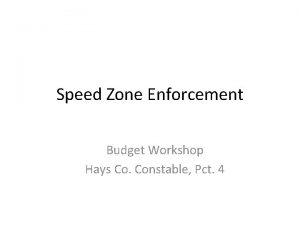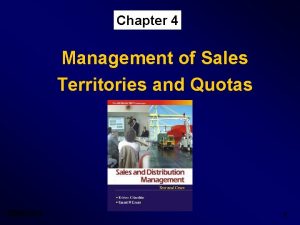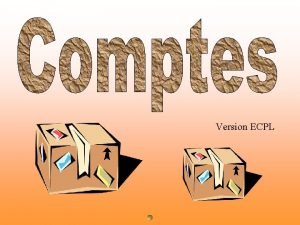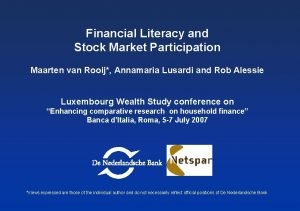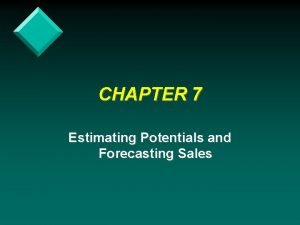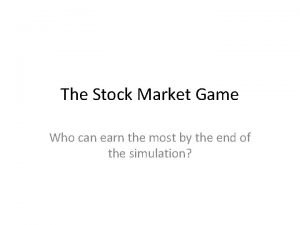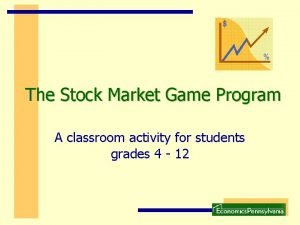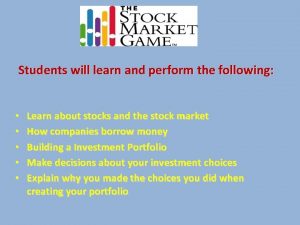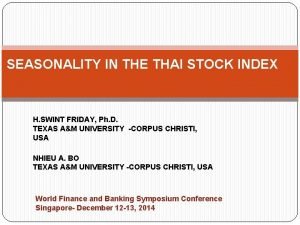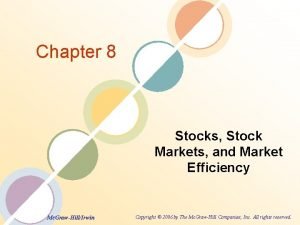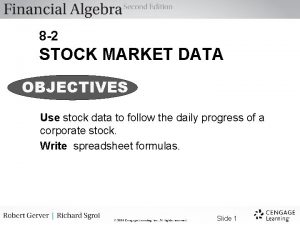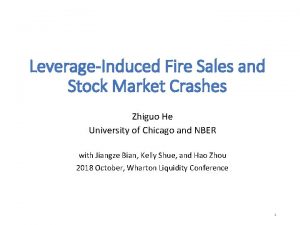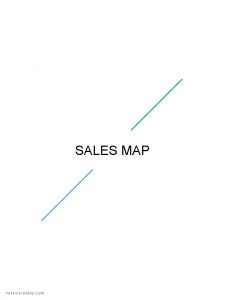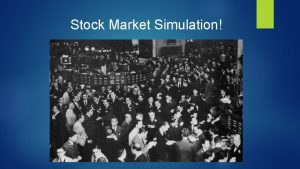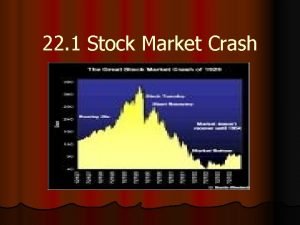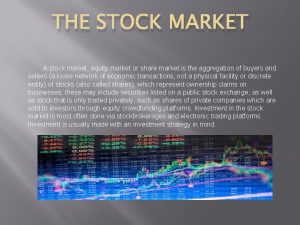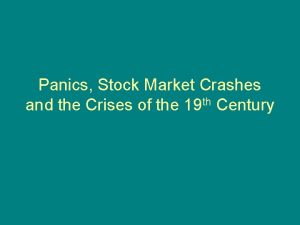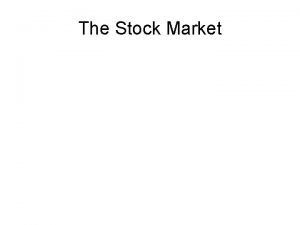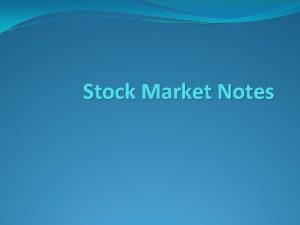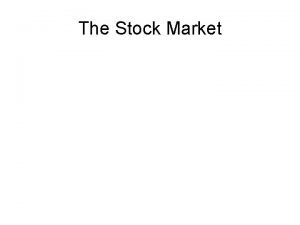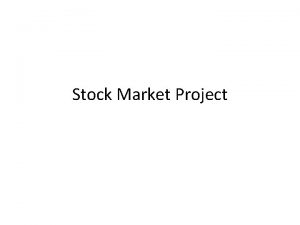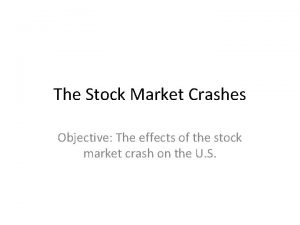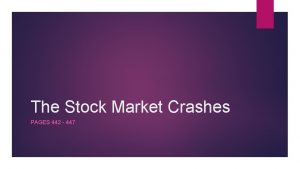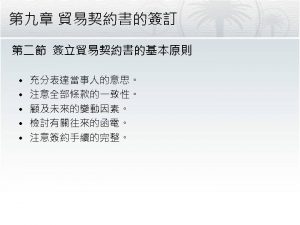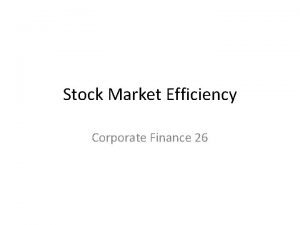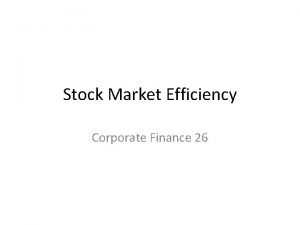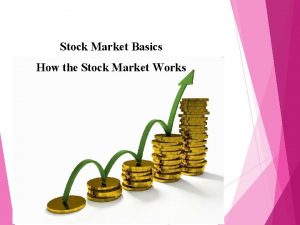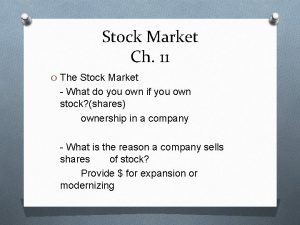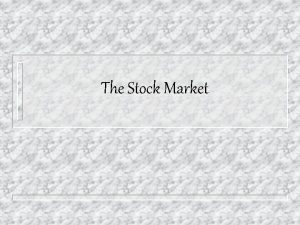LeverageInduced Fire Sales and Stock Market Crashes Zhiguo































- Slides: 31

Leverage-Induced Fire Sales and Stock Market Crashes Zhiguo He University of Chicago and NBER with Jiangze Bian, Kelly Shue, and Hao Zhou 2018 October, Wharton Liquidity Conference 1

INTRODUCTION • Excessive leverage and fire sales are believed to have been major contributors to many past financial crises • • • 1929 US stock market crash 2007/08 financial and housing crises 2015 Chinese stock market crash • Limited empirical evidence on fire sales in financial markets, and not in context of leverage • E. g. , Coval and Stafford (2007) and Edmans, Goldstein and Jiang (2012): fire sale of equities due to fund outflows • Ellul, Jotikasthira, and Lundblad (2011): fire sale of downgraded corporate bonds due to regulatory constraints • This paper: Direct evidence of leverage-induced fire sales • Account-level trading data for margin accounts in Chinese stock market in 2015 • Examine role of shadow-financed margin trading and regulation 2

2015 CHINESE STOCK MARKET BACKGROUND • Stock market boomed in early 2015 and then crashed in summer of 2015 • Two types of margin accounts were popular starting in mid-2014 1. Brokerage-financed margin system • Similar to US margin trading (initial margin, maintenance margin, etc. ) • Tightly regulated, with minimum initial margin and maintenance margin 2. Shadow-financed margin system • • “Mother account” operated by some online platforms • Looks like a normal unlevered brokerage account with huge trading volume • Linked through Fin. Tech software to many levered “child accounts” (retail traders) Unregulated grey area: higher leverage, lower maintenance margin, and larger cross-sectional variation 3

DIAGRAM OF MARGIN TRADING SYSTEM • Chinese shadow margin system is connected to Chinese shadow banking (say, Trust, Wealth Management Products, etc) • June 12 2015: CSRC (China Securities Regulation Commission) released draft rules for a future ban on new shadow-financed margin accounts 4

DIAGRAM OF SHADOW MARGIN TRADING • Mother-Child system, against the regulation that each individual ID can only have one trading account. 5

DATA • Detailed account-level trading during the crisis (May-July 2015) • Brokerage-financed margin accounts (Brokerage) from a leading brokerage firm, cleaned sample represents ~5% of market share of brokerage margin service • Shadow-financed margin accounts (Shadow) from a leading web-based peer-topeer lending platform • Hard to estimate its market share: Best estimate for cleaned sample: ~5% • Each individual account in both categories • Daily stock holdings and trading • Daily assets and debt, leverage = assets/(assets-debt) • Account maximum allowable leverage (Pingcang Line, 平仓线) • Stock market data: returns, volume, etc. 6

LEVERAGE AND THE MARKET INDEX (1) • Large dispersion of account leverage over the sample index, right scale leverage, left scale 7

LEVERAGE AND THE MARKET INDEX (2) • Leverage = Assets/Equity. • Asset-weighted and equity-weighted are quite different! index, right scale leverage, left scale 8

PREVIEW OF RESULTS Accounts with higher risk of margin calls are more likely to sell assets • Compare net selling of the same stock on the same day, across accounts with different “distance-to-margin-call” • A construction similar to Merton’s distance-to-default These fire sales affect stock prices • Stocks disproportionately held by fire-sale accounts (accounts with low distance-to-margin-call) high selling pressure • …. experience significant short run price declines that eventually reverse Potential concern: these stocks would have fallen in value for other reasons • Less likely to explain the long run reversal • Event studies around regulatory tightening announcements aid in identification 9

DISTANCE TO MARGIN CALL (1) 10

DISTANCE TO MARGIN CALL (2) 11

DISTANCE TO MARGIN CALL IN THE DATA 12

ACCOUNT-LEVEL EVIDENCE 13

ACCOUNT-LEVEL EVIDENCE 14

BROKERAGE AND SHADOW 15

LEVERAGE OR LEVERAGE CONSTRAINT? In general, rebalancing in a leveraged account will generate sales that are observationally equivalent to “fire sales” • Kyle-Xiong (2001), He-Krishnamurthy (2013), etc: w/o margin constraint • Garleanu-Pederson (2011) etc: with margin constraint Identified selling intensity due to leverage is the combination of above force • Results are robust to the conservative classification of Z<0 as “fire-sale accounts” We make some headway in “ruling in” the role of leverage constraint • Shadow account sample with heterogeneous Pingcang Lines allows us to identify the role of leverage constraints controlling for the leverage • Endogenous choice of Pingcang Lines due to heterogeneous risk aversion? We instrument the account Pingcang Line (see next slide) 16

LEVERAGE OR LEVERAGE CONSTRAINT? 17

EVENT STUDY: REGULATION TIGHTENING • Regulations on shadow-financed margin system released on June 12 th, 2015 • Compare selling intensity in week before and after announcements for brokerage and shadow accounts • This regulatory shock is more relevant for shadow accounts • Identification: Stock fundamentals are unlikely to change at the same time as these announcements) 18

STOCK-LEVEL EVIDENCE 19

STOCK-LEVEL EVIDENCE • Stocks with higher FSE are correlated with 1) worse past performance and 2) higher volatility • Do stocks with higher FSE has more net sellings from fire-sale accounts? Fire Sale Exposure (FSE) Return Volatility Size (Market Cap) Turnover Past 10 -day cum. return Past 10 -day daily return Stock FE Date FE Observations R-squared (1) (2) (3) (4) Net selling of stock from fire sale accounts 0. 106*** 0. 111*** 0. 110*** (0. 0228) (0. 0343) (0. 0344) X X X X X 116, 809 20 0. 144 0. 186 0. 187

NET SELLING BY FIRE SALE ACCOUNTS TO TOTAL VOLUME • • • Sample restricted to stocks in the top decile of FSE on each day On average, net selling by fire sale accounts corresponds to 0. 3% of volume Our sample = approximately 5% of margin market! 21

RETURNS AND FIRE SALES 22

AVERAGE PORTFOLIO RETURNS 23

RETURNS FOLLOWING FIRE SALES 24

RETURNS FOLLOWING FIRE SALES CAR % 1 Day 3 Days FSE -0. 103*** -0. 255*** SE % (0. 03) (0. 06) 5 Days 10 Days 20 Days -0. 398*** -0. 506*** -0. 162*** (0. 08) (0. 11) (0. 08) 40 Days 0. 0438 (0. 06) • Standard errors clustered at date level • Controls: return volatility, market cap, past 10 -day daily and cumulative returns; turnover; stock fixed effect; date fixed effect • We have standardized FSE measure here 25

FURTHER EVIDENCE • The relation b/w FSE and price drops is substantially stronger immediately following regulatory tightening announcements. • The reversal is unlikely to be caused by Chinese government bailout effort • • Current literature shows that the government does not know details about the margin system in China (Bian, Da, Lou, Zhou (2018), and Bian, He, Shi, Zhu (2018)) Correlation between government purchase and individual stock FSE is close to 0 26

BROKERAGE VS SHADOW 27

28

SHADOW OR BROKERAGE? CAR % 1 Day 3 Days 5 Days 10 Days 20 Days 40 Days FSE of shadow -0. 108*** -0. 269*** -0. 112 0. 030 SE (0. 03) (0. 07) (0. 09) (0. 12) (0. 099) (0. 048) FSE of brokerage -0. 0187*** -0. 0441*** -0. 118*** 0. 0326 SE (0. 008) (0. 0141) (0. 0339) (0. 0463) -0. 414*** -0. 523*** -0. 0784** -0. 106*** (0. 0228) (0. 0211) • Regress CAR on FSE, constructed using just the Shadow or Brokerage samples • Coefficients represent the change in CAR for a std dev change in FSE • FSE constructed using the Shadow sample has larger effect and explanatory power 29

MARKET FEEDBACK 30

CONCLUSION 31
 Requirements for effective segmentation
Requirements for effective segmentation Most work zone crashes
Most work zone crashes Most work zone crashes dmv
Most work zone crashes dmv Speeding crashes
Speeding crashes Market leader challenger follower nicher examples
Market leader challenger follower nicher examples Features of preferred stock
Features of preferred stock Characteristics of common shares
Characteristics of common shares Ales force structure
Ales force structure Difference between sales letter and sales promotion letter
Difference between sales letter and sales promotion letter Salesforce sales organization structure
Salesforce sales organization structure Management of sales territories and quotas
Management of sales territories and quotas Teknik pengolahan makanan dalam pembuatan stock adalah
Teknik pengolahan makanan dalam pembuatan stock adalah Stock final de marchandises
Stock final de marchandises Stock market crash def
Stock market crash def Financial literacy and stock market participation
Financial literacy and stock market participation Sales potential vs sales forecast
Sales potential vs sales forecast Reichstag fire who was the fire starter
Reichstag fire who was the fire starter Fire damper access
Fire damper access Fire hose reel signage standards
Fire hose reel signage standards A-e rwi
A-e rwi Fire extinguisher parts
Fire extinguisher parts Difference between sales potential and market potential
Difference between sales potential and market potential Activity sheet 3: stock market calculations answer key
Activity sheet 3: stock market calculations answer key Kansas stock market game
Kansas stock market game Classroom stock market game
Classroom stock market game Stock market crash in 1929
Stock market crash in 1929 Activity sheet 1 about p/e ratios answer key
Activity sheet 1 about p/e ratios answer key Stock market crash political cartoon
Stock market crash political cartoon Black tuesday political cartoon
Black tuesday political cartoon Thai stock market set index series
Thai stock market set index series Chapter 8 the stock market
Chapter 8 the stock market 8-2 stock market data
8-2 stock market data



